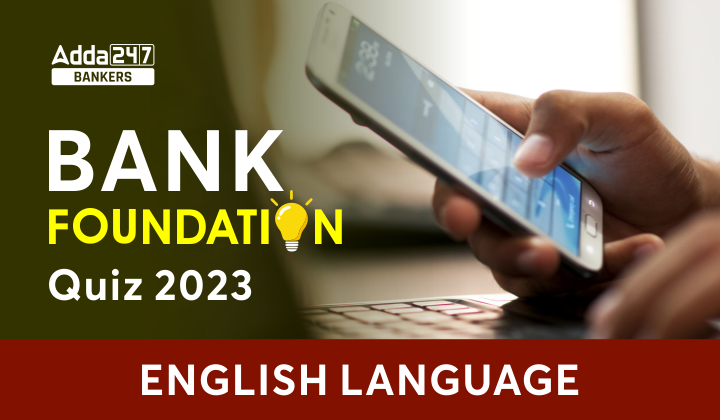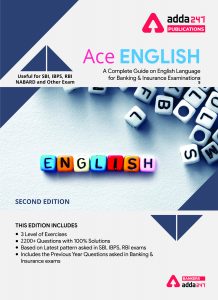Directions (1-7): Read each sentence to find out whether there is any grammatical or idiomatic error in it. The error, if any, will be in one part of the sentence. The number of that part is the answer. If there is ‘No error’, the answer is e). (Ignore errors of punctuation, if any.)
Q1. Neither (A)/ Rakesh nor (B)/ Shakti, presented their (C)/ papers before the deadline for doing so. (D)/. No error (E).
(a)A
(b)B
(c) C
(d)D
(e)No Error
Q2. A recent (A)/ poll has indicated (B)/ that Binny is considered (C)/ brighter than any student in the class (D)/. No error (E).
(a)A
(b)B
(c) C
(d)D
(e)No Error
Q3. The company is planning (A)/ a training (B)/ programme for their (C)/ senior officers sometime in December. (D)/ No error (E).
(a)A
(b)B
(c) C
(d)D
(e)No Error
Q4. There was only (A)/ a loaf of bread and two bottles of milk in the (B)/ refrigerator when (C)/ we came back after a weekend in Manali. (D)/ No error (E).
(a)A
(b)B
(c) C
(d)D
(e)No Error
Q5. Nuclear waste will still be (A)/ radioactive even after twenty thousand years, (B)/ so it must be disposed (C)/ of very carefully. (D)/ No error (E)
(a)A
(b)B
(c) C
(d)D
(e)No Error
Q6. The pain and grief that has (A)/transcending the generations since (B)/the JallianwalaBagh Massacre must (C)/ never be dismissed or denied(D)/ no error (E)
(a)A
(b)B
(c) C
(d)D
(e)No Error
Q7. Someone who refuses to let (A)/ a blind person pay in an (B)/economic transaction essentially branded (C)/the latter as a supplicant. (D)/ no error (E)
(a)A
(b)B
(c) C
(d)D
(e)No Error
Directions (8-11): In each of the questions given below four words are given in bold. These four words may or may not be in their correct position. The sentence is then followed by options with the correct sequence of words in order to make the sentence grammatically and contextually correct. If the sentence is correct as it then select option (e) as your choice.
Q8.According to the United Nations active (A) database, the fell (B) of Indians aged between 20 and 59 years — those one would consider to be the most (C) population work seekers — actually proportion (D) from 46.9 per cent in 1950 to 45.8 per cent in 1990.
(a) DBCA
(b) ADBC
(c) BCAD
(d) CDAB
(e) No rearrangement required.
Q9. Jharkhand faces the same malaise (A) that many other small Indian cities do—a crippling (B) lack of industrial(C) activities that can create (D) jobs.
(a) DBCA
(b) ADBC
(c) BCAD
(d) CABD
(e) No rearrangement required.
Q10.The indicator (A) of Ranchi’s economy, representative of a economic (B) of India’s up-and-coming cities, is also a good character(C) for why India’s slew (D) growth is now down to less than 5%.
(a) DBCA
(b) BCAD
(c) CDAB
(d) ABDC
(e) No rearrangement required.
Q11. In the 18th converted(A), British Judge Tilman Henckell floated the Sunderbans Plan. Under this plan, known as the first land reform initiative (B) in the state, the vast wasteland was century (C) into agricultural land and the revenue (D) was distributed among the people.
(a) CABD
(b) CBAD
(c) BCAD
(d) ACDB
(e) No rearrangement required.
Directions (12-15): In the sentences given below, four words have been highlighted and placed in a sentence. Identify the correct sequence of the words in the sentence. Also, one of the given words will need to be replaced. Identify the correct sequence and the correct replacement and mark that option as your answer.
Q12. The fact of the (A) bipartisan is that there is a rare (B) dangerous consensus in the U.S. that China is becoming an increasingly (C) developmental challenge to American global (D) matter.
(a) CADB; B- daggers
(b) DABC; C- denomination
(c) DABC; C- dominance
(d) CADB; D- mattress
(e) No interchange required
Q13. The (A) breach bilateral trade (B) current between the U.S. and China is about $400 billion in 2018, a figure that was (C) initiation cited by President Trump to justify his (D) repeatedly of the trade war.
(a) BDAC; C- intimation
(b) BDAC; D- revered
(c) BADC; A- imbalance
(d) BADC; A- polarity
(e) No interchange required
Q14. The trade imbalance between the U.S. and China will (A) foreseeable, and will continue to (B) rivalry the (C) persist between the two countries for the (D) fuel future.
(a) CDBA; A- foreseen
(b) CDBA; B- revolutionary
(c) CDBA; all words are correct
(d) CDBA; B- fervently
(e) No interchange required
Q15. The country has become more open to (A) foreign companies (B) operating in China, even in the (C) financial sector where many (D)retrospect are being removed.
(a) DABC; A- feign
(b) BCDA; all words are correct
(c) DABC; B- opinionated
(d) ABCD; D- restrictions
(e) No interchange required
Solutions
S1. Ans.(c)
Sol. presented his papers before…’
Singular antecedent (Rakesh and Shakti) joined by or or nor are referred to by singular pronoun (his).
S2. Ans.(d)
Sol. ‘….brighter than any other student….’
In a comparative construction we must be sure that if A and B are compared, A is not included as a part of B.
S3. Ans.(c)
Sol. ‘…. training programme for its….’
A singular pronoun-adjective (its, not their) must be used to refer to a collective noun (company) when the members of the collective noun are considered a unit.
S4. Ans.(a)
Sol. ‘….there were only…..’
The subject of the sentence is plural (a bread and bottles). Therefore, the verb must be plural (were, not was). Here the word there is not the subject.
S5. Ans.(e)
Sol. There is no error in the statement.
S6. Ans. (b)
Sol. ‘transcending’ will be replaced by ‘transcended’ as we use ‘third form of verb’ with ‘has or have.
S7. Ans. (c)
Sol. ‘branded’ will be replaced by ‘brands’ as the sentences is in present tense.
S8. Ans. (d)
Sol. The correct sequence of the given words is CDAB.
In the given sentence the order of the words which make the most contextual and grammatical sense is option (d) .Hence the answer would be (d).
Proportion: a part, share, or number considered in comparative relation to a whole.
S9. Ans. (e)
Sol. The correct sequence of the given words is ABCD.
In the above given sentence the words are arranged in a contextually and grammatically correct manner hence the answer would be option (e) i.e. no rearrangement required.
Malaise: a general feeling of discomfort, illness, or unease whose exact cause is difficult to identify.
Crippling: causing a person to become unable to walk or move properly.
S10. Ans. (c)
Sol. The correct sequence of the given words is CDAB.
In the given sentence the order of the words which make the most contextual and grammatical sense is option (c) .Hence the answer would be (c).
Slew: a large number of
indicator: a thing that indicates the state or level of something.
Character: the mental and moral qualities distinctive to an individual.
S11. Ans. (b)
Sol. The correct sequence of the given words is CBAD.
In the given sentence the order of the words which make the most contextual and grammatical sense is option (b) .Hence the answer would be (b).
Converted: having been adapted to be suitable for a new purpose.
Initiative: the ability to assess and initiate things independently.
Revenue: is the income that a business has from its normal business activities.
S12. Ans. (c)
Sol. Among the given words, the most suitable rearrangement of the highlighted words will be DABC. Also, ‘developmental’ will need to be replaced with ‘dominance’ to make the statement grammatically correct and contextually meaningful. Hence, option (c) is the most suitable answer choice.
S13. Ans. (c)
Sol. Among the given words, the most suitable rearrangement of the highlighted words will be BADC. Also, ‘breach’ will need to be replaced with ‘imbalance’ to make the statement grammatically correct and contextually meaningful. Hence, option (c) is the most suitable answer choice.
S14. Ans. (c)
Sol. Among the given words, the most suitable rearrangement of the highlighted words will be CDBA. Also, all the given words make the statement grammatically correct and contextually meaningful. Hence, option (c) is the most suitable answer choice.
S15. Ans. (d)
Sol. Among the given words, the most suitable rearrangement of the highlighted words will be ABCD. Also, ‘retrospect’ will need to be replaced with ‘restrictions’ to make the statement grammatically correct and contextually meaningful. Hence, option (d) is the most suitable answer choice.











 English Language Quiz For Bank Foundatio...
English Language Quiz For Bank Foundatio...
 English Language Quiz For Bank Mains Exa...
English Language Quiz For Bank Mains Exa...







